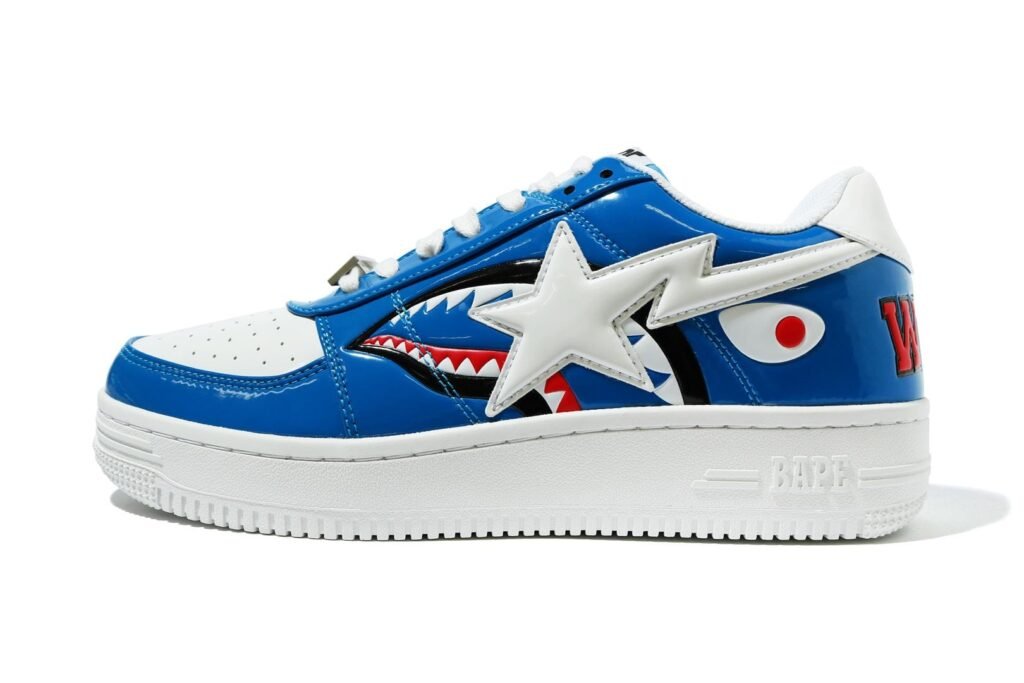The BAPESTA sneaker is a revolutionary product born from the creative vision of Nigo, the founder of Japanese streetwear brand A Bathing Ape (BAPE). Launched in the early 2000s, BAPESTA quickly became a global phenomenon due to its bold design, cultural appeal, and celebrity endorsements. It emerged during a time when Japanese street fashion was gaining international attention, and Nigo utilized this moment to introduce a sneaker that would bridge the gap between high fashion, hip-hop, and urban street culture. The name “BAPESTA” is a blend of BAPE and the suffix “-sta,” derived from the word “gangsta,” representing rebellion and attitude, aligning with the brand’s streetwear roots.
Inspired Design That Echoes Western Classics
BAPESTA is most famous for its design, which closely resembles the silhouette of the Nike Air Force 1. However, Nigo added distinct features that made the sneaker instantly recognizable. Instead of Nike’s iconic swoosh, BAPESTA features a bold shooting star logo often called the “STA.” The sneaker also showcased vivid colorways, patent leather materials, and eye-catching graphics that made it stand out on the street. While some saw it as a derivative design, sneakerheads and fans of streetwear considered it a homage that offered a unique Eastern twist on a Western classic.
The Role of Celebrity Culture in BAPESTA’s Rise
One of the major catalysts behind BAPESTA’s rise was its popularity among American hip-hop artists and celebrities. Stars like Pharrell Williams, Kanye West, Soulja Boy, and Lil Wayne frequently wore BAPESTAs, showcasing them in music videos, concerts, and public appearances. These high-profile endorsements elevated the sneaker from a niche product in Japan to a worldwide streetwear icon. This connection between fashion and music not only boosted sales but also solidified BAPESTA’s place in youth culture and sneaker history. The sneaker wasn’t just footwear; it became a status symbol and a marker of coolness in the early 2000s.
Exclusive Drops and Limited Releases Fuel Hype
BAPE is known for its exclusivity and limited-edition releases. The BAPESTA followed this strategy with high-impact collaborations and colorways that were available only in select quantities and regions. This scarcity created a frenzy among collectors and streetwear enthusiasts who sought to own a piece of fashion history. Limited runs, pop-up events, and region-specific styles added to the mystique and desirability of the shoe. Owning a pair of BAPESTAs became not only a fashion statement but also a collector’s achievement, with rare pairs often reselling for significantly higher prices in the secondary market.
Design Evolution and Artistic Collaborations
Over the years, BAPESTA has undergone several redesigns and reinterpretations, keeping it fresh for new generations. Collaborations with brands and artists such as Marvel, KAWS, Undefeated, and Comme des Garçons introduced new aesthetics to the iconic silhouette. These partnerships brought creativity and diversity to the product line, making each drop a blend of fashion, art, and innovation. The constant evolution of the BAPESTA design also reflects BAPE’s commitment to staying ahead of the curve, ensuring that the sneaker remains relevant in a constantly changing fashion landscape.
Cultural Significance and Global Impact
BAPESTA’s cultural impact extends far beyond footwear. It represents a fusion of Eastern creativity and Western pop culture. The sneaker’s global appeal helped introduce Japanese streetwear to the world, influencing major fashion capitals and inspiring numerous other brands. The success of BAPESTA also played a crucial role in cementing A Bathing Ape as a major force in the fashion industry. By blending high fashion with urban street elements, BAPESTA broke the mold and opened the door for other streetwear brands to gain mainstream acceptance.
The Comeback and Renewed Popularity
After a quiet period in the mid-2010s, BAPESTA has seen a resurgence in recent years. Vintage fashion trends, nostalgia for early 2000s style, and the renewed popularity of streetwear have all contributed to its comeback. New releases have been more refined, incorporating premium materials and modern design elements while retaining the signature boldness that defines the BAPESTA identity. This resurgence has reintroduced the sneaker to a new generation while reigniting interest among longtime fans and collectors.
Sustainability and the Future of BAPESTA
As fashion shifts toward sustainability and ethical practices, BAPE and its BAPESTA line are slowly adapting to these changes. Although the brand has not fully embraced eco-conscious production, there are increasing discussions around using sustainable materials and more transparent manufacturing processes. The future of BAPESTA likely includes this evolution, along with digital innovations such as NFT-based sneaker ownership, augmented reality fittings, and continued collaboration with futuristic designers.
Conclusion: Why BAPESTA Remains an Iconic Sneaker
The BAPESTA sneaker is more than just a stylish item—it’s a cultural artifact that symbolizes innovation, boldness, and artistic expression. From its controversial design origins to its global influence in fashion and music, BAPESTA has carved out a unique space in sneaker history. Its ability to stay relevant across decades, its loyal fanbase, and its impact on the aesthetics of streetwear ensure that BAPESTA will remain a staple in the world of fashion for years to come.












































